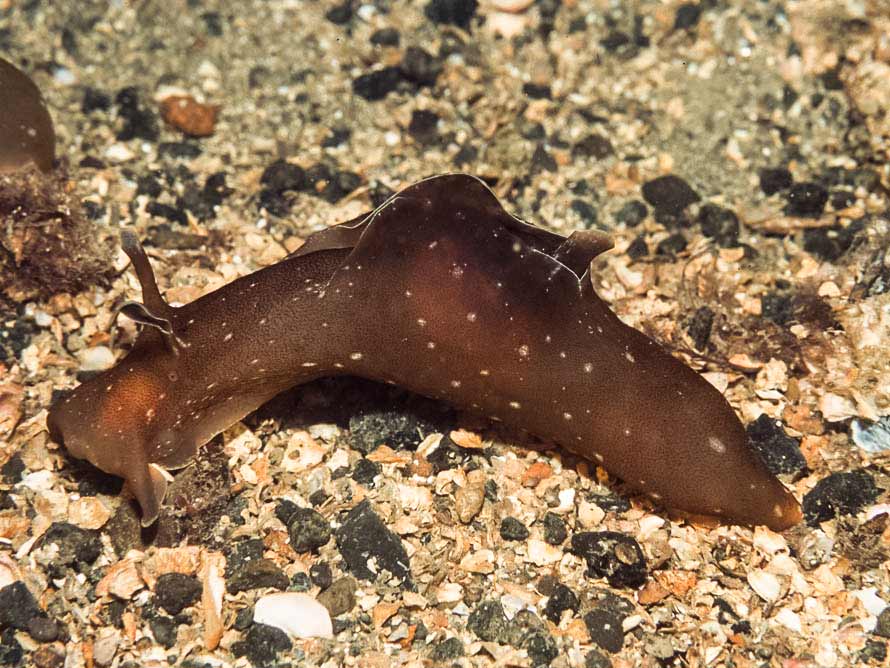Few people like slugs. While I consider them to be pests for
eating too many of our garden plants, I rather like the forms that live in
water and, especially Aplysia, the
“sea hare”.
Philip Henry Gosse, the great Nineteenth Century Natural Historian
and populariser, encouraged readers of his books to discover the animals of the
coast and he wrote, in Tenby, 1
that specimens of Aplysia..
..crawled, or rather glided, along over the stones upon a fat fleshy disk
or foot, and up the slender stems of Sea-weeds by bringing the edges of the same
muscular foot to meet around the stem, grasping it thus, as if enclosed in a
tube. The fore part, as the animal progressed, was poked forward as a narrow
neck, furnished with two pairs of tentacles; one pair of which, standing erect,
and being formed of thin laminae, bent round so as to bring the edges nearly
into contact, looked like the long ears of a beast; whence this creature is
called by the vulgar the Sea-hare (by naturalists, Aplysia punctata). On each side of the body, which is large and
semi-oval, rises up a great fold of flesh (the mantle), which, arching over the
back, is itself overlapped by its fellow on the opposite side. These wings are
sometimes carried apart, exposing the back, and are said to be used as swimming
fins; but this I cannot confirm from my own observation.
Nine years later,
in A Year at the Shore, 2
Gosse is more dismissive about descriptions of swimming by Aplysia, writing:
It is reported that these mantle-lobes are capable of being used as
swimming-fins, by their undulations; but I doubt the correctness of the
observation.
As can be seen from the clip above, he was mistaken.
Another feature of
this slug, described by Gosse, 1 is its ability to exude clouds of purple
“fluid”:
Sometimes on being disturbed, and sometimes quite spontaneously, or at
least without any visible cause, they would pour out from beneath the
mantle-lobes a copious fluid of the richest purple hue, which stained the
stones, the sands, and the water, of the same gorgeous tinge.. ..a few hours
sufficed to remove all trace of it.
In both Tenby and A Year at the Shore, Gosse also describes the complex gut
found in Aplysia, with chambers
modified for holding food, milling it and then digesting the milled contents. He concludes the descriptions of the mollusc by saying:
..the whole organization affords us an
instructive example of the Divine resources, and of the adaptation of organs to
their requirements which an enlightened research is continually finding in
Creation.
The sense of wonder is no less in those of us who consider that all the adaptations
result from the selection of genetic mutations. Whether we believe in The
Creation or in evolution, we can all agree that these slugs crawl by means of
muscular waves passing over the foot; they can swim; they produce a dye to act as a diversion when disturbed; and they have a
gut structure that is well adapted to their diet of strengthened seaweeds. The
interesting question for an evolutionist is how did all these adaptations come
about? What were the precursors, if precursors were present, or were there
sudden mutations producing changes in the form and function we observe? It is
easy to see how the gut structure enabled more efficient digestion of an
abundant source of food, but how important was predation pressure in selecting
for genetic changes that resulted in swimming and dye production? We do not
know the answers, but pondering the possibilities is fascinating, although such
thoughts would have been inconceivable to Gosse the Creationist.
I am an old-fashioned Zoologist, a Natural Historian, so looking at the
wide diversity of animals and considering their adaptations and way of life
comes as second nature to me. This approach, driven by a child-like curiosity,
is now much less common in learned circles, as we move to a strongly
anthropocentric and more “useful” Zoology. A contemporary student is unlikely
to learn about the Natural History of Aplysia
as described by Gosse, but be more familiar with the role the slug plays in applied
research:
The marine
mollusk Aplysia californica is an important animal for experiments in
cellular, molecular and behavioral neuroscience because of the distinctive
organization of its nervous system, which makes it appropriate for cellular
analysis of a variety of behaviors, learning and memory. Aplysia
presents a one-of-a-kind model for developmental and neurophysiological
studies. 3
It is interesting that this quote
is given under the title “Scientific Importance” and it represents a growing
trend in using organisms as models. 4
I am sure that these
investigations are of value but they say little about the animal in its natural
environment and that is the main interest of a Natural Historian. It could be
suggested that contemporary Biologists spend too much time dwelling on humans,
and models for humans, without looking at the extraordinary natural world of
which we are a part. That’s a bit preachy, but I’m sure that Henry Gosse would
feel the same way. No doubt, critics of this view would suggest that I am
looking backward, not forward, in suggesting that all organisms should be viewed
in the context of their natural environment. However, we wreck environments in
the cause of human advancement, and Modern Biology does little to address that
issue. Rather, it encourages us to be concerned with all aspects of human
health and wellbeing without being involved in the wider context of the health
of the Earth. Is that wise?
1 Philip Henry Gosse (1856) Tenby: a sea-side holiday. London, John Van Voorst.
2 Philip Henry Gosse (1865) A Year at the Shore. London, Alexander Strahan.


No comments:
Post a Comment